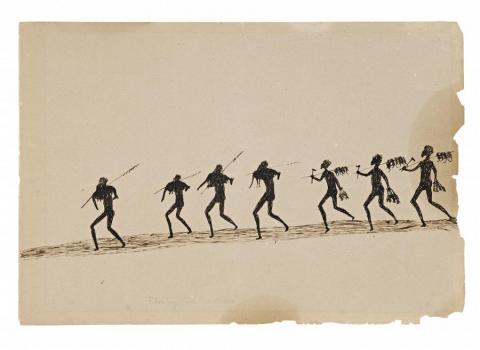RETURNING FROM THE CHASE, c.1890
Tommy McRae
ink on paper
24.0 x 35.0 cm
titled lower centre: Returning from the chase
Acquired directly from the artist by George McMahon, a customs officer at Albury, New South Wales/Victoria border
Thence by descent
Private collection, Melbourne
Sotheby's, Melbourne, 24 July 2007, lot 3
Private collection, Melbourne
Returning from Hunting, pen and ink, 23.0 x 33.8 cm, in Sayers, A., Aboriginal Artists of the Nineteenth Century, Oxford University Press, Melbourne in association with the National Gallery of Australia, Canberra, 1997, p. 49 (illus.)
When we think of drawings of nineteenth century Australian social history, images of early convicts and Sydney Town spring to mind. Or engravings from the Melbourne Punch in the 1850s, keen to make a satirical point about democratic ambition, social milieu and a fledgling egalitarianism. By the end of the century The Bulletin was established which, amongst many traits, not only railed against contemporary Chinese immigration but proved equally racist towards Aboriginal people in its written and pictorial production.
Far removed from all this was Tommy McRae, a keen observer of the conduct of new settlers that surrounded him and a man of deep reflection upon the disappearance of his own people and culture. Based mainly in Northern Victoria on the Murray River at Lake Moodemere, he worked as a stockman and, in his later life, as an artist where he was, perhaps surprisingly, widely admired and supported within the local area.1
His drawings are serious, witty and sharply observed in their idiosyncratic way, typically offering a rich and wonderful account of the newly arrived (including the Chinese) alongside the depiction of the activities of his own people.
In this work, however, he recounts traditional hunting. Drawn in pen and ink and not with a stick as romantic, apocryphal accounts might suggest, the decorative, frieze-like pattern of figures moves across the page as silhouettes – figures with spears holding the success from a 'chase' in which wallabies and possums may be easily identified. Delicate and modest in its execution it is, unequivocally, McRae's celebration of his people.
1. The most accurate description of the artist's movement around this area are described in Sayers, A., Aboriginal Artists of the Nineteenth Century, Oxford University Press, Melbourne in association with the National Gallery of Australia, Canberra, 1997, pp. 113 – 114.
